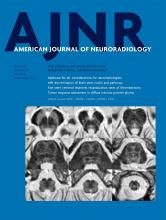Index by author
Fujiwara, S.
- Adult BrainOpen AccessAcetazolamide-Loaded Dynamic 7T MR Quantitative Susceptibility Mapping in Major Cerebral Artery Steno-Occlusive Disease: Comparison with PETK. Fujimoto, I. Uwano, M. Sasaki, S. Oshida, S. Tsutsui, W. Yanagihara, S. Fujiwara, M. Kobayashi, Y. Kubo, K. Yoshida, K. Terasaki and K. OgasawaraAmerican Journal of Neuroradiology May 2020, 41 (5) 785-791; DOI: https://doi.org/10.3174/ajnr.A6508
Fukuda, T.
- FELLOWS' JOURNAL CLUBNeurointerventionYou have accessPredictors of Cerebral Aneurysm Rupture after Coil Embolization: Single-Center Experience with Recanalized AneurysmsY. Funakoshi, H. Imamura, S. Tani, H. Adachi, R. Fukumitsu, T. Sunohara, Y. Omura, Y. Matsui, N. Sasaki, T. Fukuda, R. Akiyama, K. Horiuchi, S. Kajiura, M. Shigeyasu, K. Iihara and N. SakaiAmerican Journal of Neuroradiology May 2020, 41 (5) 828-835; DOI: https://doi.org/10.3174/ajnr.A6558
The authors evaluated a total of 426 unruptured aneurysms and 169 ruptured aneurysms that underwent coil embolization in their institution between January 2009 and December 2017. Recanalization occurred in 38 (8.9%) of 426 unruptured aneurysms and 37 (21.9%) of 169 ruptured aneurysms. The Modified Raymond-Roy Classification on DSA was used to categorize the recanalization type. In untreated recanalized aneurysms, class IIIb aneurysms ruptured significantly more frequently than class II and IIIa. In the ruptured group, the median follow-up term was 28.0 months. Retreatment for recanalization was performed in 16 aneurysms. Four of 21 untreated recanalized aneurysms (2.37% of total coiled aneurysms) ruptured. Class IIIb aneurysms ruptured significantly more frequently than class II and IIIa. Coiled aneurysms with class IIIb recanalization should undergo early retreatment because of an increased rupture risk.
Fukumitsu, R.
- FELLOWS' JOURNAL CLUBNeurointerventionYou have accessPredictors of Cerebral Aneurysm Rupture after Coil Embolization: Single-Center Experience with Recanalized AneurysmsY. Funakoshi, H. Imamura, S. Tani, H. Adachi, R. Fukumitsu, T. Sunohara, Y. Omura, Y. Matsui, N. Sasaki, T. Fukuda, R. Akiyama, K. Horiuchi, S. Kajiura, M. Shigeyasu, K. Iihara and N. SakaiAmerican Journal of Neuroradiology May 2020, 41 (5) 828-835; DOI: https://doi.org/10.3174/ajnr.A6558
The authors evaluated a total of 426 unruptured aneurysms and 169 ruptured aneurysms that underwent coil embolization in their institution between January 2009 and December 2017. Recanalization occurred in 38 (8.9%) of 426 unruptured aneurysms and 37 (21.9%) of 169 ruptured aneurysms. The Modified Raymond-Roy Classification on DSA was used to categorize the recanalization type. In untreated recanalized aneurysms, class IIIb aneurysms ruptured significantly more frequently than class II and IIIa. In the ruptured group, the median follow-up term was 28.0 months. Retreatment for recanalization was performed in 16 aneurysms. Four of 21 untreated recanalized aneurysms (2.37% of total coiled aneurysms) ruptured. Class IIIb aneurysms ruptured significantly more frequently than class II and IIIa. Coiled aneurysms with class IIIb recanalization should undergo early retreatment because of an increased rupture risk.
Funakoshi, Y.
- FELLOWS' JOURNAL CLUBNeurointerventionYou have accessPredictors of Cerebral Aneurysm Rupture after Coil Embolization: Single-Center Experience with Recanalized AneurysmsY. Funakoshi, H. Imamura, S. Tani, H. Adachi, R. Fukumitsu, T. Sunohara, Y. Omura, Y. Matsui, N. Sasaki, T. Fukuda, R. Akiyama, K. Horiuchi, S. Kajiura, M. Shigeyasu, K. Iihara and N. SakaiAmerican Journal of Neuroradiology May 2020, 41 (5) 828-835; DOI: https://doi.org/10.3174/ajnr.A6558
The authors evaluated a total of 426 unruptured aneurysms and 169 ruptured aneurysms that underwent coil embolization in their institution between January 2009 and December 2017. Recanalization occurred in 38 (8.9%) of 426 unruptured aneurysms and 37 (21.9%) of 169 ruptured aneurysms. The Modified Raymond-Roy Classification on DSA was used to categorize the recanalization type. In untreated recanalized aneurysms, class IIIb aneurysms ruptured significantly more frequently than class II and IIIa. In the ruptured group, the median follow-up term was 28.0 months. Retreatment for recanalization was performed in 16 aneurysms. Four of 21 untreated recanalized aneurysms (2.37% of total coiled aneurysms) ruptured. Class IIIb aneurysms ruptured significantly more frequently than class II and IIIa. Coiled aneurysms with class IIIb recanalization should undergo early retreatment because of an increased rupture risk.
Futami, K.
- LetterYou have accessReply:K. Futami, K. Misaki and M. NakadaAmerican Journal of Neuroradiology May 2020, 41 (5) E27; DOI: https://doi.org/10.3174/ajnr.A6474
Gajjar, A.
- Pediatric NeuroimagingYou have accessNeuroimaging Findings in Children with Constitutional Mismatch Repair Deficiency SyndromeA. Kerpel, M. Yalon, M. Soudack, J. Chiang, A. Gajjar, K.E. Nichols, Z. Patay, S. Shrot and C. HoffmannAmerican Journal of Neuroradiology May 2020, 41 (5) 904-910; DOI: https://doi.org/10.3174/ajnr.A6512
Gandhi, D.
- NeurointerventionYou have accessA Critical Assessment of the Golden Hour and the Impact of Procedural Timing in Stroke ThrombectomyA.P. Wessell, H.D.P. Carvalho, E. Le, G. Cannarsa, M.J. Kole, J.A. Stokum, T. Chryssikos, T.R. Miller, S. Chaturvedi, D. Gandhi, K. Yarbrough, S.R. Satti and G. JindalAmerican Journal of Neuroradiology May 2020, 41 (5) 822-827; DOI: https://doi.org/10.3174/ajnr.A6556
Ganzoui, I.
- Adult BrainYou have accessStructural Connectivity and Cortical Thickness Alterations in Transient Global AmnesiaJ. Hodel, X. Leclerc, M. Zuber, S. Gerber, P. Besson, V. Marcaud, V. Roubeau, H. Brasme, I. Ganzoui, D. Ducreux, J.-P. Pruvo, M. Bertoux, M. Zins and R. LopesAmerican Journal of Neuroradiology May 2020, 41 (5) 798-803; DOI: https://doi.org/10.3174/ajnr.A6530
Geerlings, M.I.
- LetterYou have accessReply:M.H.T. Zwartbol, A.G. van der Kolk and M.I. GeerlingsAmerican Journal of Neuroradiology May 2020, 41 (5) E32; DOI: https://doi.org/10.3174/ajnr.A6516
Geng, S.
- Head and Neck ImagingOpen AccessMRI Signal Intensity and Electron Ultrastructure Classification Predict the Long-Term Outcome of Skull Base ChordomasJ. Bai, J. Shi, S. Zhang, C. Zhang, Y. Zhai, S. Wang, M. Li, C. Li, P. Zhao, S. Geng, S. Gui, L. Jing and Y. ZhangAmerican Journal of Neuroradiology May 2020, 41 (5) 852-858; DOI: https://doi.org/10.3174/ajnr.A6557








